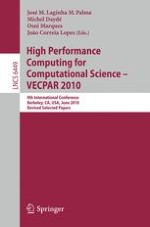2011 | OriginalPaper | Chapter
HPC Techniques for a Heart Simulator
Authors : Takumi Washio, Jun-ichi Okada, Seiryo Sugiura, Toshiaki Hisada
Published in: High Performance Computing for Computational Science – VECPAR 2010
Publisher: Springer Berlin Heidelberg
Activate our intelligent search to find suitable subject content or patents.
Select sections of text to find matching patents with Artificial Intelligence. powered by
Select sections of text to find additional relevant content using AI-assisted search. powered by
In the post-genome era, the integration of molecular and cellular findings in studies into the functions of organs and individuals is recognized as an important field of medical science and physiology. Computational modeling plays a central role in this field, which is referred to as Physiome. However, despite advancements in computational science, this task remains difficult. In addition to coupling multiple disciplines, including electricity, physical chemistry, solid mechanics and fluid dynamics, the integration of events over a wide range of scales must also be accomplished. Our group, including clinical practitioners, has been tackling this problem over several years, with a focus on the human heart.
The morphology of our heart model is reconstructed from human multi-detector computed tomography data and discretized using the finite element method. For the electrophysiology simulation, a composite voxel mesh with fine voxels in and around the heart and coarse voxels covering the torso is adopted to solve the bidomain equation. Following the excitation of a sinus node, the simulator reproduces the excitation propagation and depolarization of the membrane potentials of virtual cells sequentially in the atria, conduction system, and ventricles. The mechanical simulation for the interaction between the heart wall and intracavitary blood flow is performed on a tetrahedral mesh. The Ca
2 +
concentration data obtained from the electrophysiology model are applied to the molecular model of sarcomere dynamics to compute the contraction force of every element. This results in the synchronous contraction of the heart and blood flow.
Thus far, we have been able to retrieve and present the data in the same way as clinical diagnostic tools, such as ECG, UCG, and magneto-cardiogram in our simulation studies. These data are in good agreement with the clinical data for both normal and diseased heart models, thus suggesting their potentials for diagnostic support.
However, a more important aspect of the simulation involves modeling the underlying mechanism driving the myocardium, i.e., the origin of the pulsation of the heart, which includes electrophysiological regulation and cross-bridge kinetics in the cardiac cells. To integrate such microscopic phenomena with the macroscopic function of the organ in a seamless manner, the cardiac cells are also modeled using the finite element method, based on the cell physiology for every finite element in the heart model. The mathematical linkage is realized using the so-called homogenization method. All the cell models and the heart model are then solved simultaneously, because the instantaneous states of the macroscopic model, such as the strains and strain rates over the heart wall, also regulate each cell response. It is apparent that the total number of degrees of freedom of all the cell models becomes prohibitively large.
We will introduce basic algorithms and parallel computational techniques applied to the above mentioned multi-physics and multi-scale simulations.
